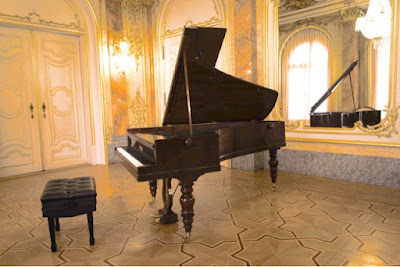 |
| A still from Roman Polanski's film Knife in the Water - Noz w Wodzie set in the Mazurian Lake District of Poland |
Click on photos to enlarge
I have just returned from a few days recreation in the superb lake district of Poland known as Mazury. Although not a secret destination for Russians, Poles or Germans (it was the former East Prussia) it is fairly unknown among English and other European travellers. In many parts one drives though tunnels of dappled shade along deserted roads lined with arching lindens and alder. Grasslands and peatlands open out onto lakes fringed with reeds, the occasional yacht leaning into the soft wind, smoothly and gently progressing across the waters as if in a dream. Birdsong fills the air and storks clack their long beaks like castanets, nesting and tending their young arrogantly exposed on impossibly high electric poles or disused chimneys. Wildlife abounds. Pine forests form on the horizon below immense open skies touched here and there by clumps of cumulus. And scarcely any people, at least at this time of year. Roman Polanski set one of his most threateningly atmospheric and to my mind best films on the Mazurian Lakes - Knife in the Water - Noz w Wodzie. It was the beginning of the modern Polish cinema and hated by the Socialists. Polanski had to leave Poland to continue his career.
I chose the rather charming and laid-back town of Gizycko close to the Kaliningrad frontier as my base mainly because I am rather a hotel fanatic. A Teutonic Knight's castle has recently been restored there and converted into a very fine luxury four star establishment known as the St. Bruno. A highly recommended hotel experienced by this admittedly jaded palate (http://www.hotelstbruno.pl/). Fine restaurant. I reflected that such an establishment would have been inconceivable when I first came to Poland in 1991. The hotel is just the sort of place I love using as a base to explore such a region. In the evenings I could watch the drama of a Euro 2012 match or my main occupation just now, correcting the English proofs of a book recently published on the extraordinarily colourful history of Zelazowa Wola, the birthplace of Chopin.
 |
| The newly opened, beautifully appointed and decorated Hotel St. Bruno at Gizycko in the Polish Mazurian Lake District. The former Teutonic Knights' Chapel to the Virgin can be seen behind the towers. |
I leave you with some photographs I took with longer captions rather than labour over purple passages as I really am pressed for time on the biography I am writing. It is just such a wonderful part of Europe I feel I should share it with you - a place to escape and renew one's faith in life, avoiding for a blessed period all the dross and violence that makes up our daily diet of disintegration and despair.
 |
| Lake Darglin in the Mazurian Lake District of Poland near Gizycko |
 |
| One approach to peace of mind in Gizycko in the Mazurian Lake District of Poland |
 |
| The swing bridge over the Gizycki Canal adjacent to the four star Hotel St. Bruno which has been converted from the original Teutonic Knight's castle. There are only two manually operated bridges like this in Europe. By a brilliant system of gears a single man can move the 100 ton structure aside to allow yachts to pass through. Attempts were made to modernise the mechanism but the manual system has now been restored as being the most efficient |
 |
| The Boyen Fortress Gizycko in the Mazurian Lake District of Poland. The structure was commissioned by the Prussian General Hermann von Boyen and completed in 1853 to defend Prussia's eastern border. It covers an area of 100 hectares and could accommodate a complement of 3000 in wartime. The fortress was stategically important throughout WW II when it was utilised by General Heinz Guderian in the camapign against Poland and for intelligence gathering activities on the Eastern Front for the High Command of the Land Forces at nearby Mamerki. Taken over by the Russians in 1945 it eventually fell into civilian use such as a chicken farm until managed as a tourist attraction by the present 'Friends of Boyen Fortress' |
 |
| The Gizycko Gate at the Boyen Fortress with a tondo of the Prussian General Hermann von Boyen |
 |
| Tondo of the Prussian General Hermann von Boyen |
 |
The Law Bastion at the Boyen Fortress
|
 |
On Lake Mamry - Mazurian Lake District of Poland
|
 |
On Lake Mamry - Mazurian Lake District of Poland
|
 |
The unusual and historic ruined Palace of Sztynort on Lake Darglin associated with the pre-eminent East Prussian family Lehndorff. First plundered and burnt by the Tatars in 1656 it has been rebuilt many times and hopefully will returned to some vestige of its former glory
|
 |
The history of the Palace of Sztynort and the owner Heinrich von Lehndorff's
heroic plot against Hitler (sign erected outside)
|
Gizycko is a useful base for those wanting not only to sail on the placid lakes and take in the picturesque views but also to visit the historic former Hitler headquarters known as Wolfschanze or 'Wolf's Lair'. This complex of bunkers was blown up by Nazi sappers as they retreated in the face of the Russians. Although absolutely unmissable if you wish to understand Hitler's paranoid megalomania and also the memorial site to the valiant plotter Colonel Claus von Stauffenberg, I have not included 'Wolf's Lair' here. I have been there before, so on this trip I planned to see the HQ of the Nazi High Command of the Land Forces (OKH) 'Anna' at Mamerki by Lake Mamery and the Masurian Canal. It is about 18kms from Wolfschanze. Whereas the Hitler bunkers are ruined, this group of some 200 different structures spread over 250 hectares are largely intact, especially the reinforced concrete structures. One gets a stronger idea of the internal arrangement of these intact bunkers. Their existence is not generally known. I am always forcibly reminded of Aztec temples disappearing inexorably under jungle foliage when I look at these bunker structures being taken over by the incursions of nature.
 |
| The 'Post Office' bunker in the HQ of the Nazi High Command of the Land Forces (OKH) 'Anna' at Mamerki |
 |
| Loopholes like this guarded every corridor entrance to every room within the intact bunkers at OKH |
 |
| 'Aztec' or 'Inca' temple slowly developing in a Polish forest Et in Arcadia Ego |
I also wanted to visit the ruins of the monumental sytem of canal locks only partially completed by the Nazis. This grand plan was intended to link the Mazurian lakes via the Mazurian Canal to the Baltic Sea. This HQ was also the meeting place for the ill-fated plotters against Hitler's life led by Colonel Claus von Stauffenberg. He completed his military service here from 1941-43.
 |
The monumental lock at Lesniewo Gorne
|
 |
Internal structure of the canal lock at Lesniewo Gorne
|
 |
| Another view of the monumental lock at Lesniewo Gorne |
 |
| Possibly less forbidding, almost innocuous, in colour |
 |
| The partially constructed lock at Lesniewo Dolne |
 |
| Our intrepid explorer MM armed with a powerful lamp to explore the dark interior of a bunker's heart. Mosquitoes almost ate me alive in there let alone the ghostly Nazi presences at my shoulder |
An interesting water tower has been restored in Gizycko which gives a fine view over the town and lakeland region thereabouts from a viewing platform. Excellent cafe with iced coffee.
 |
| Neo-Gothic Water Tower at Gizycko |

























